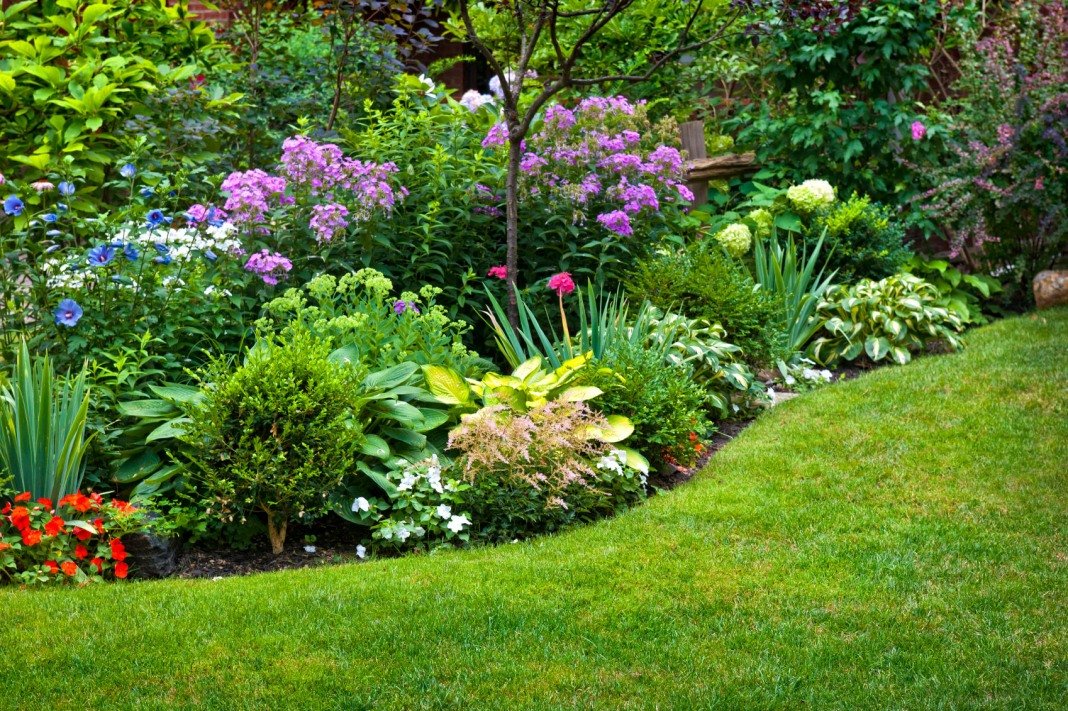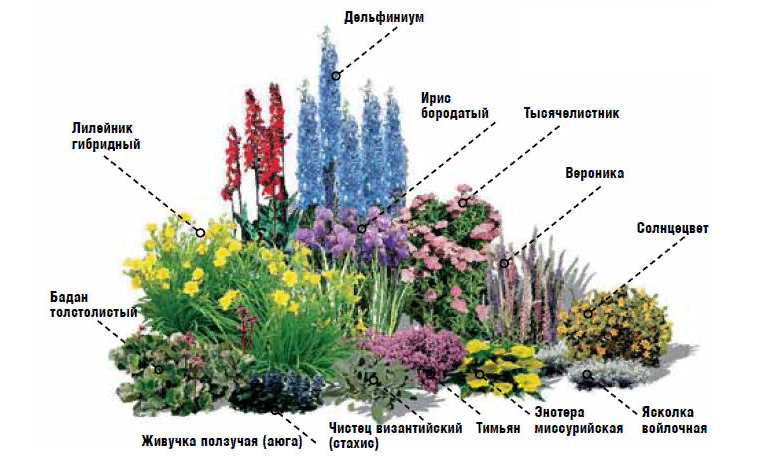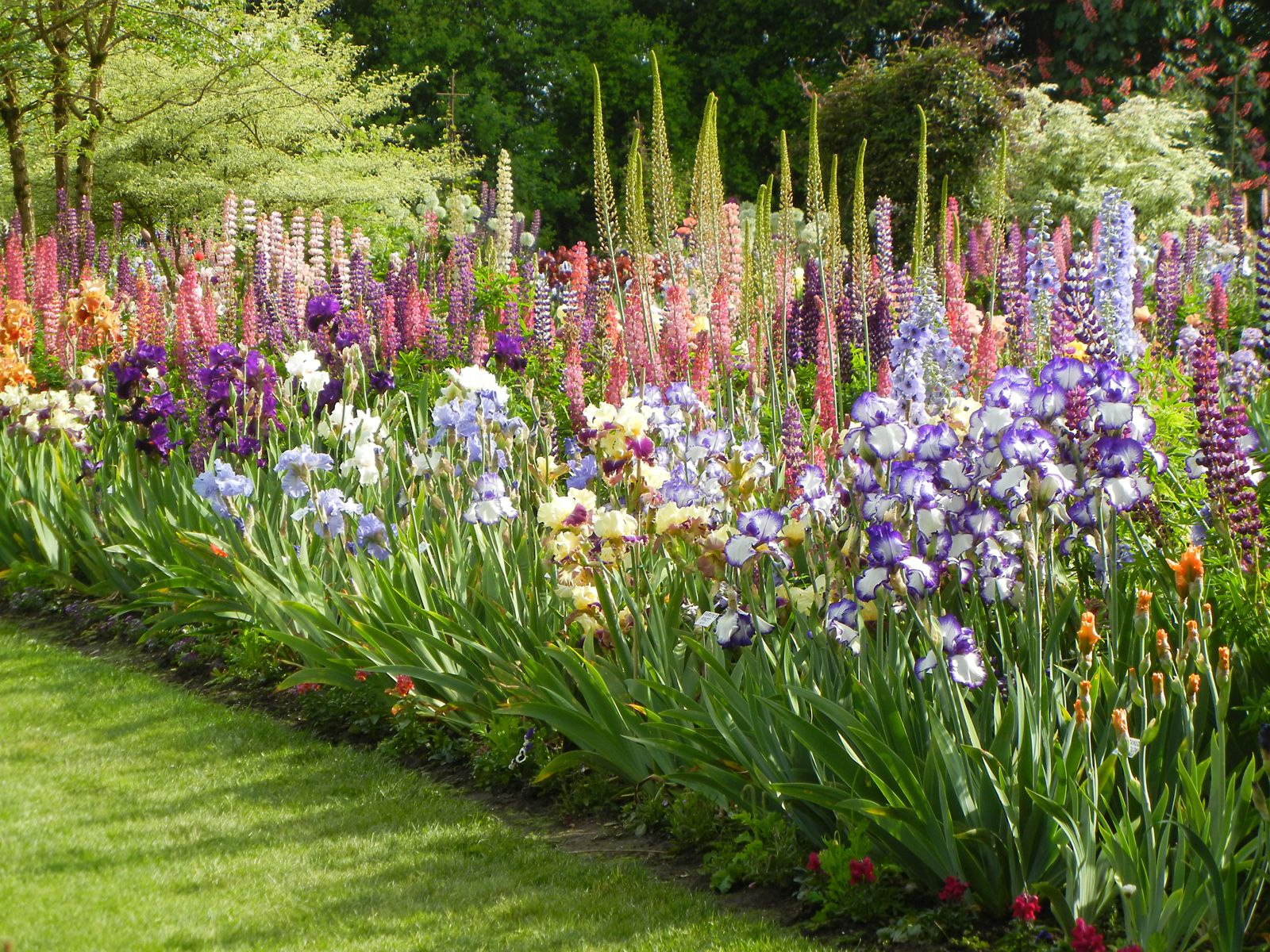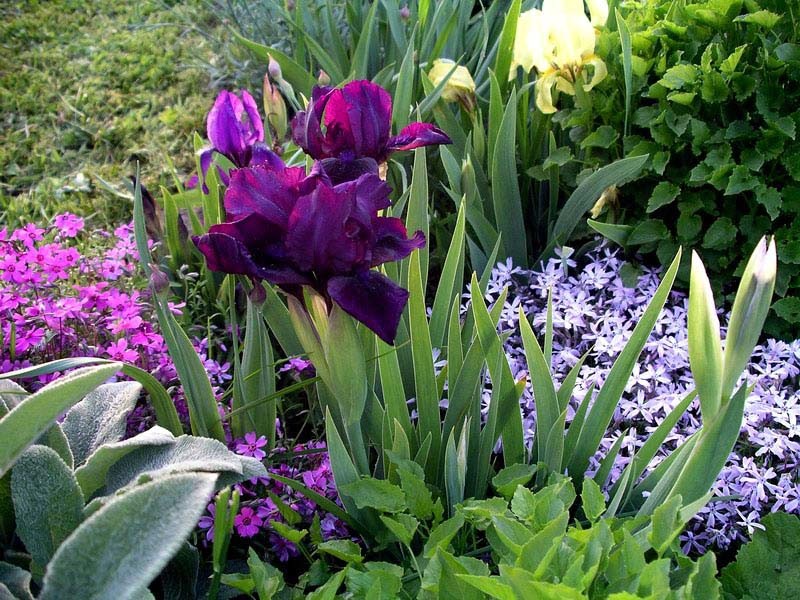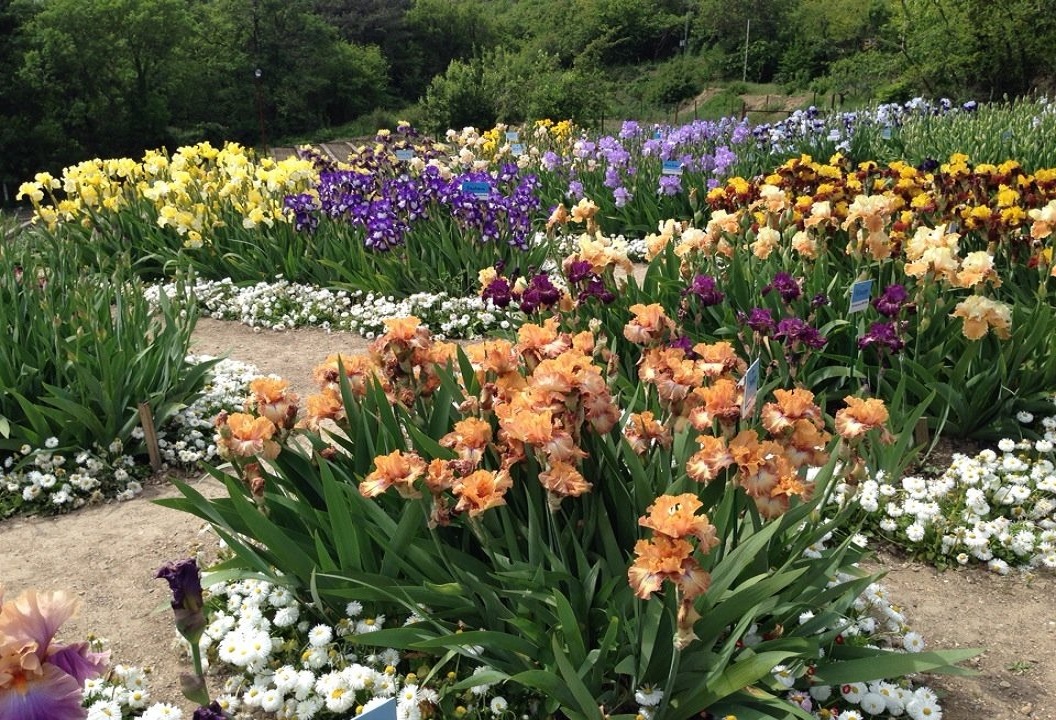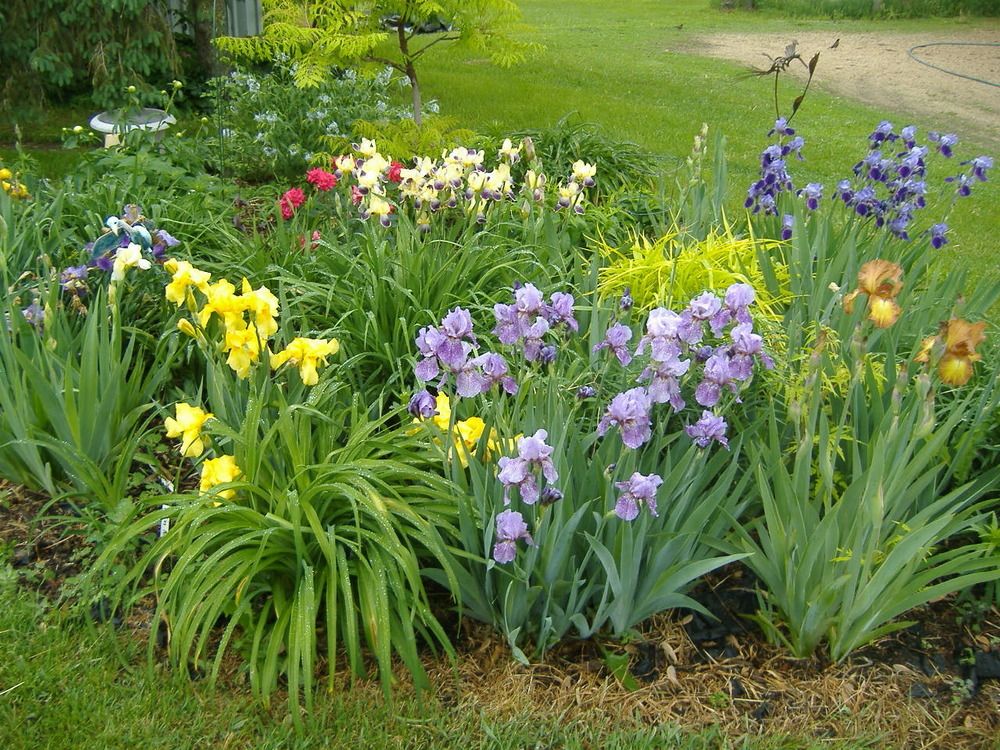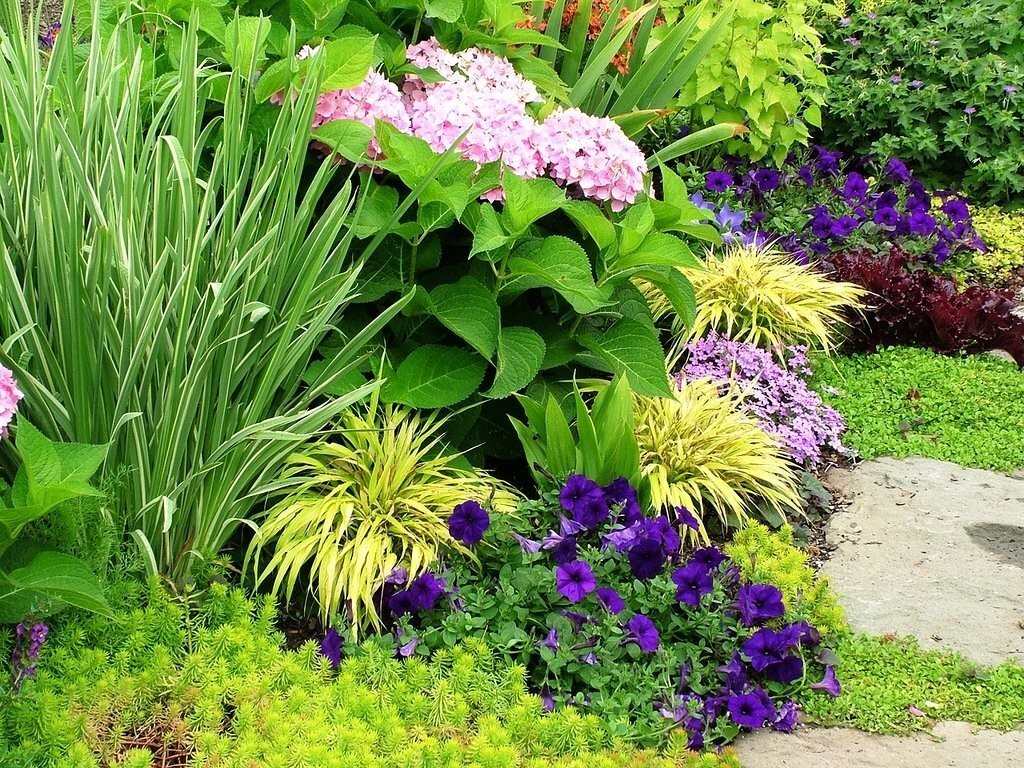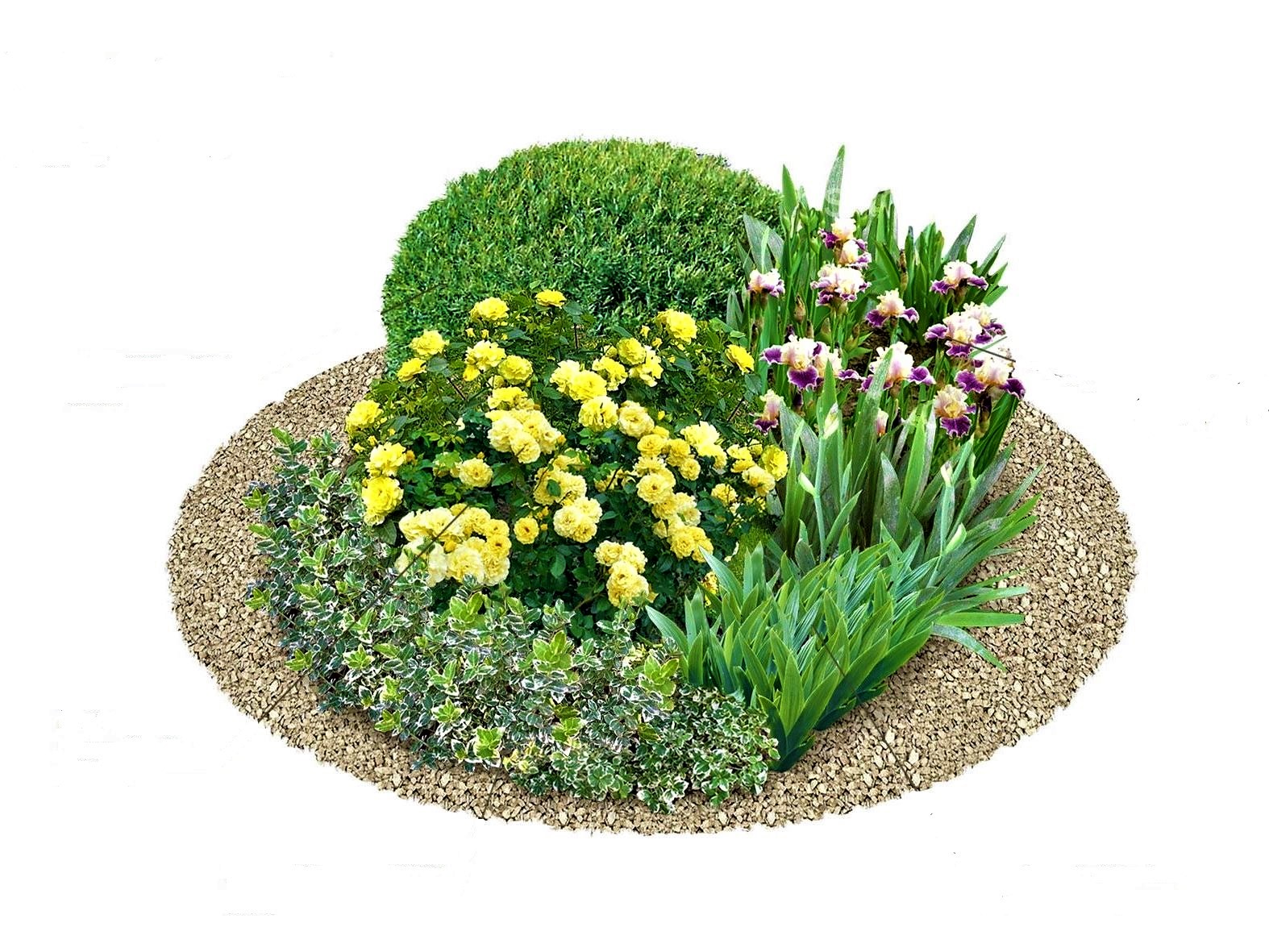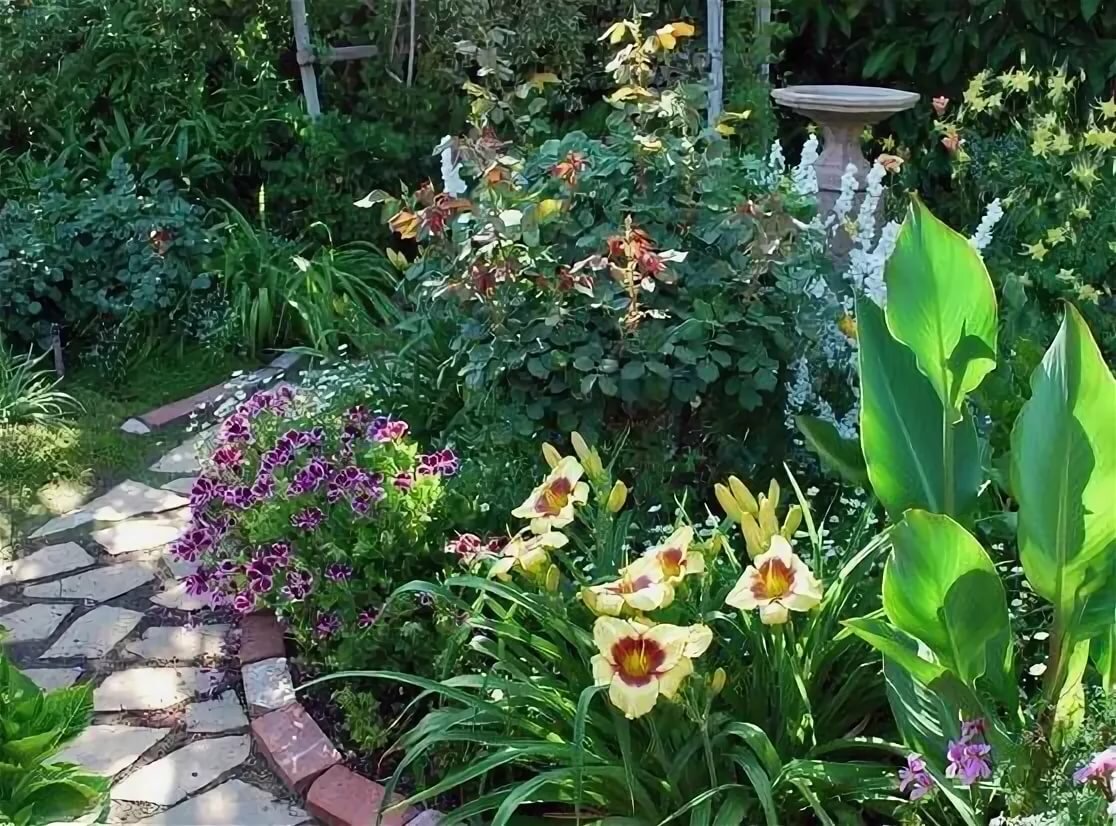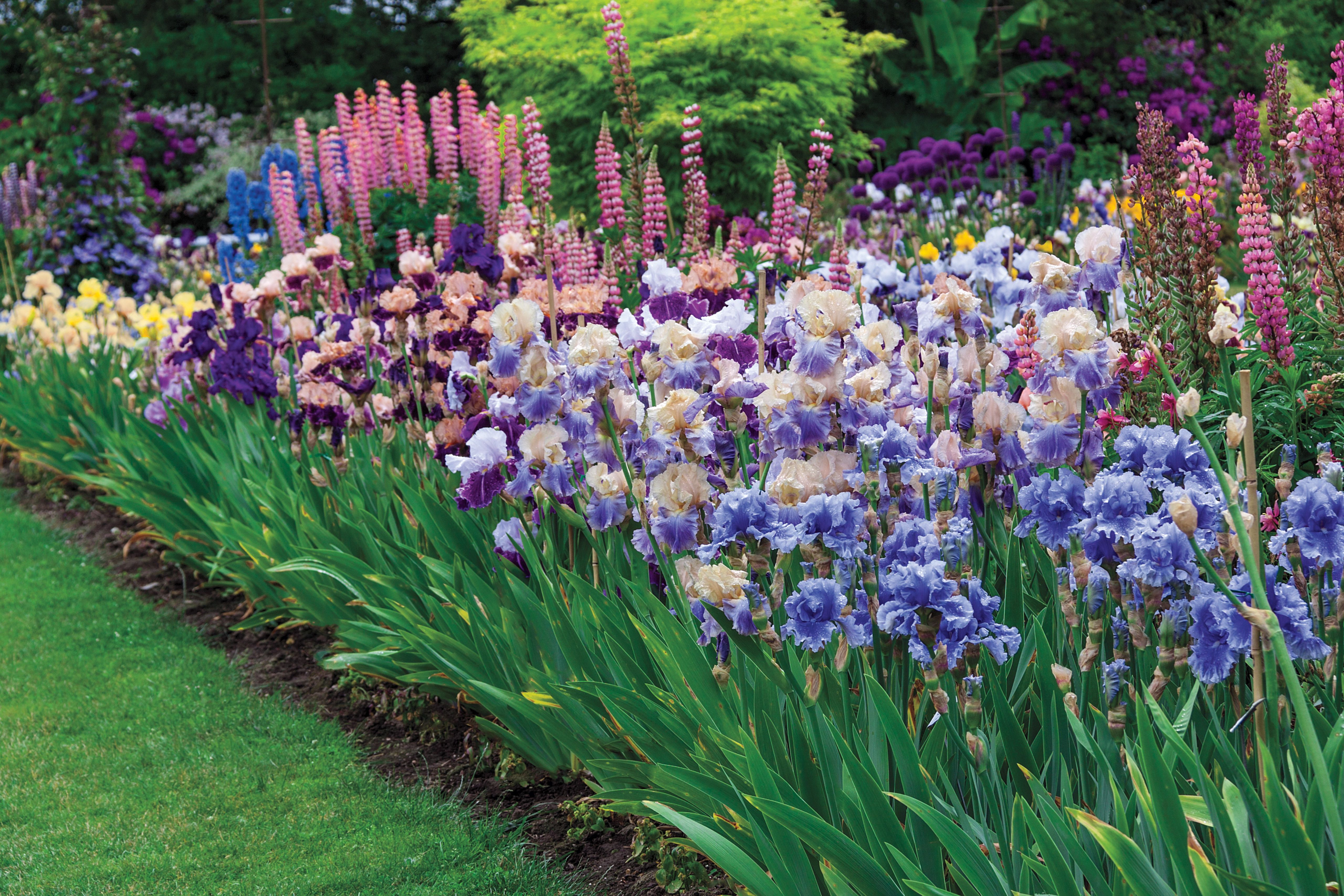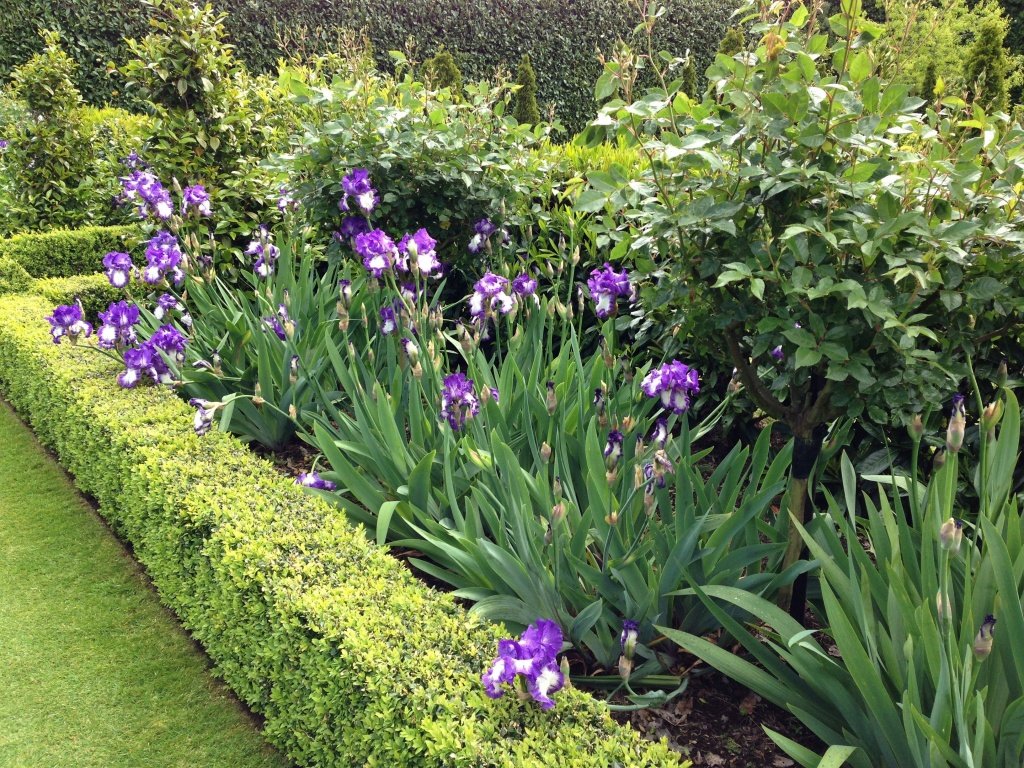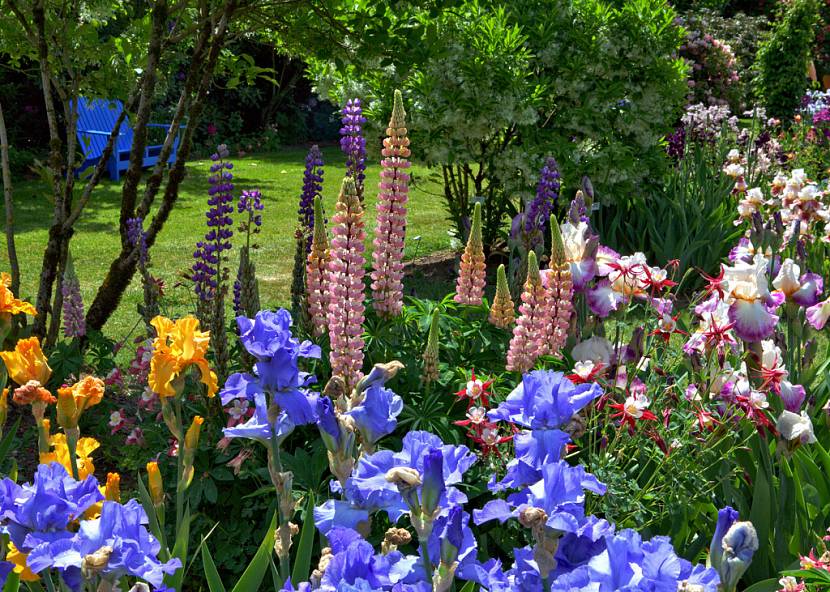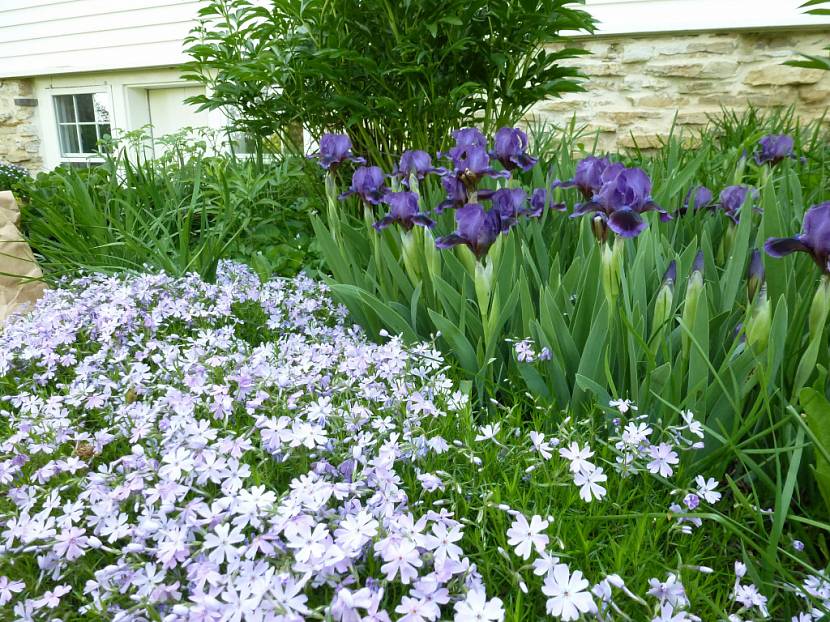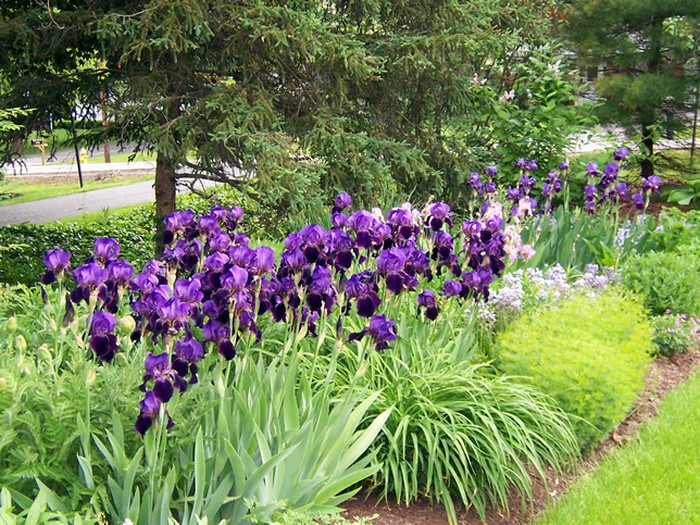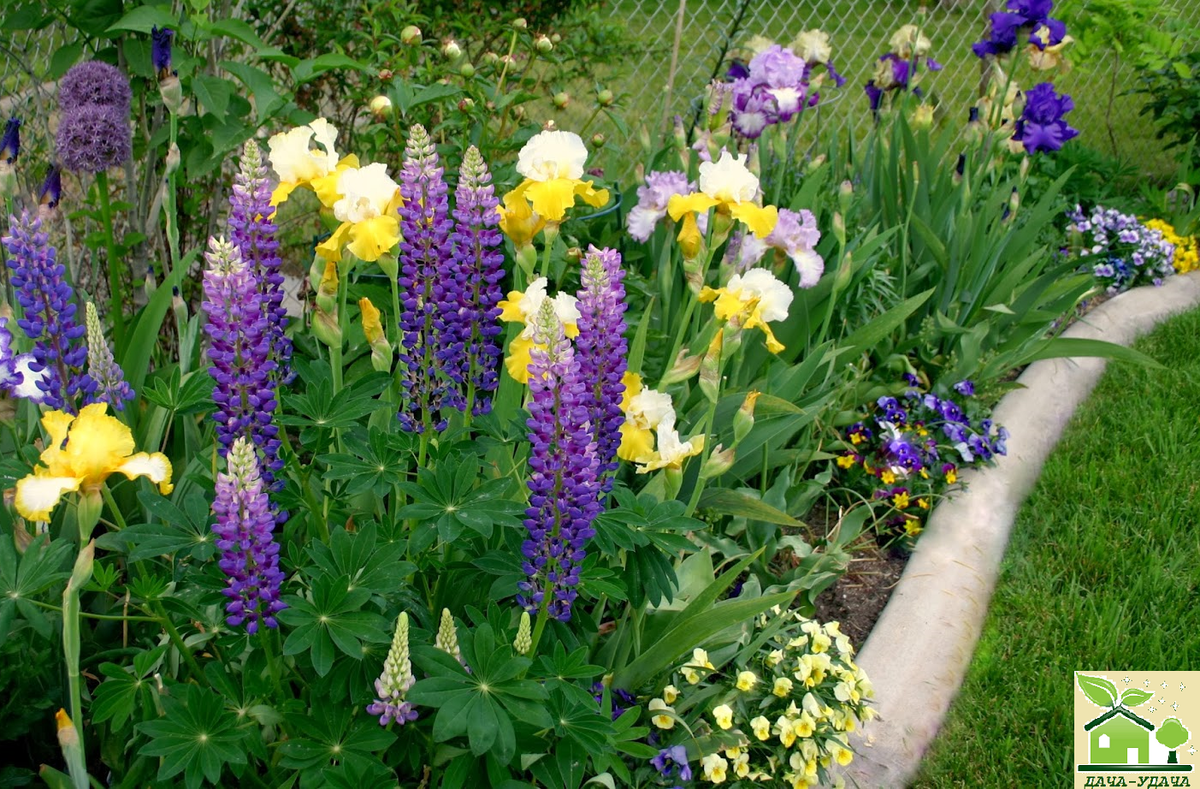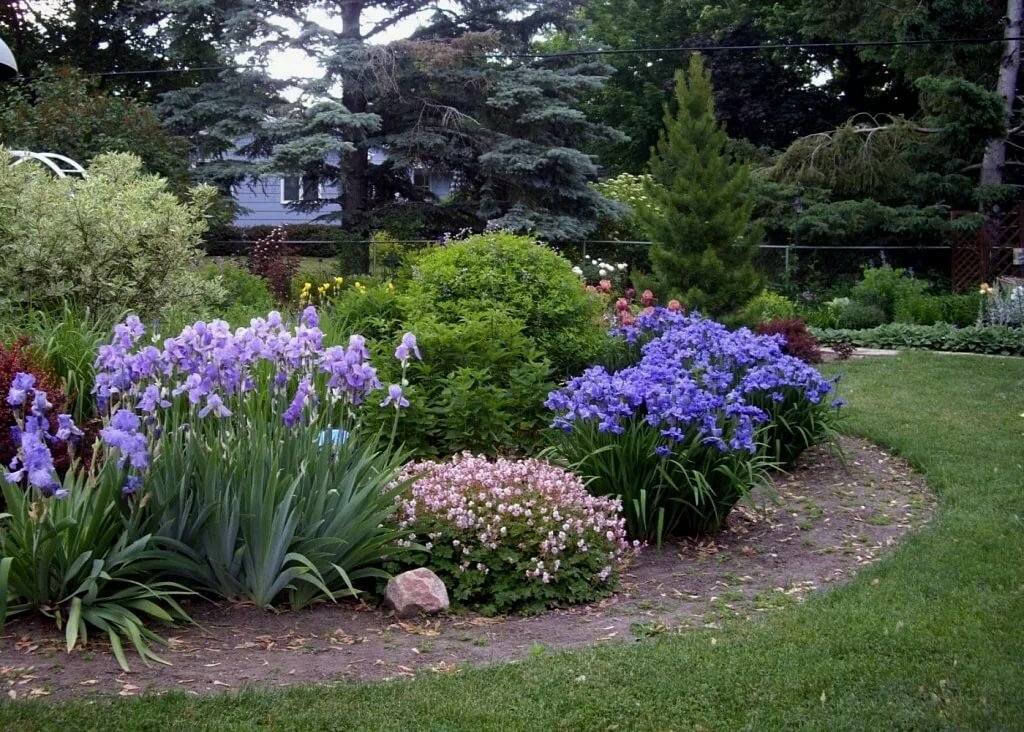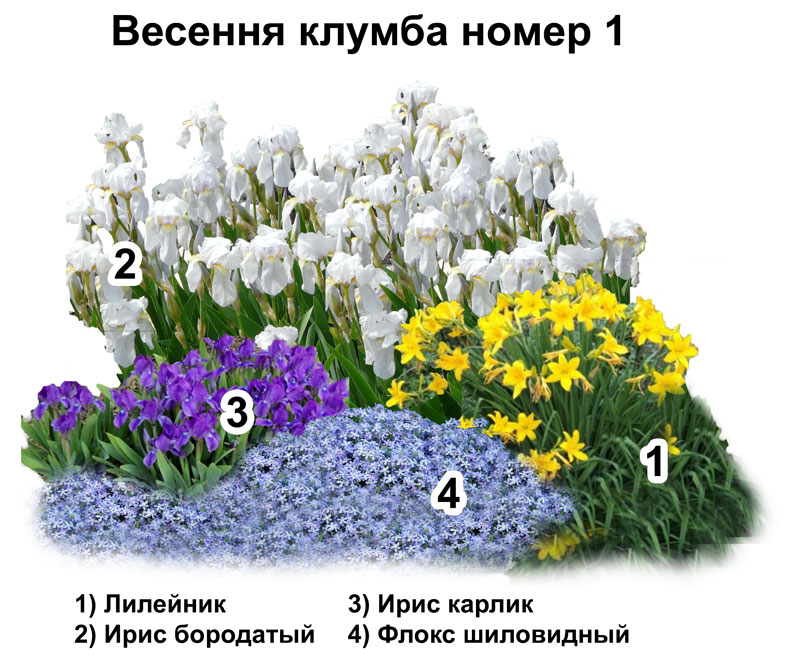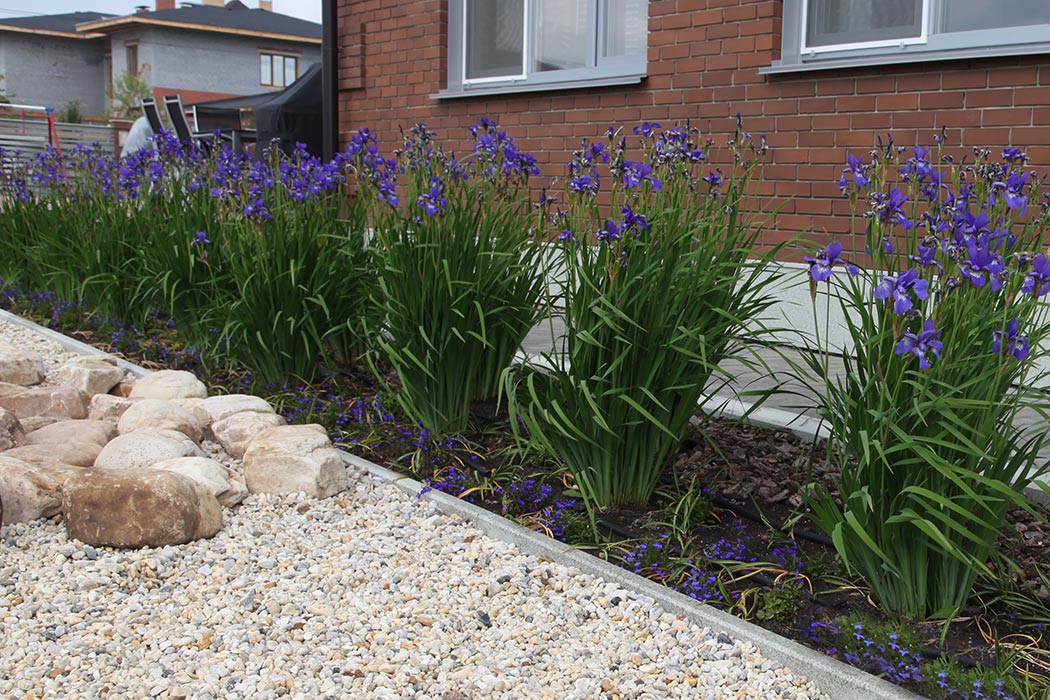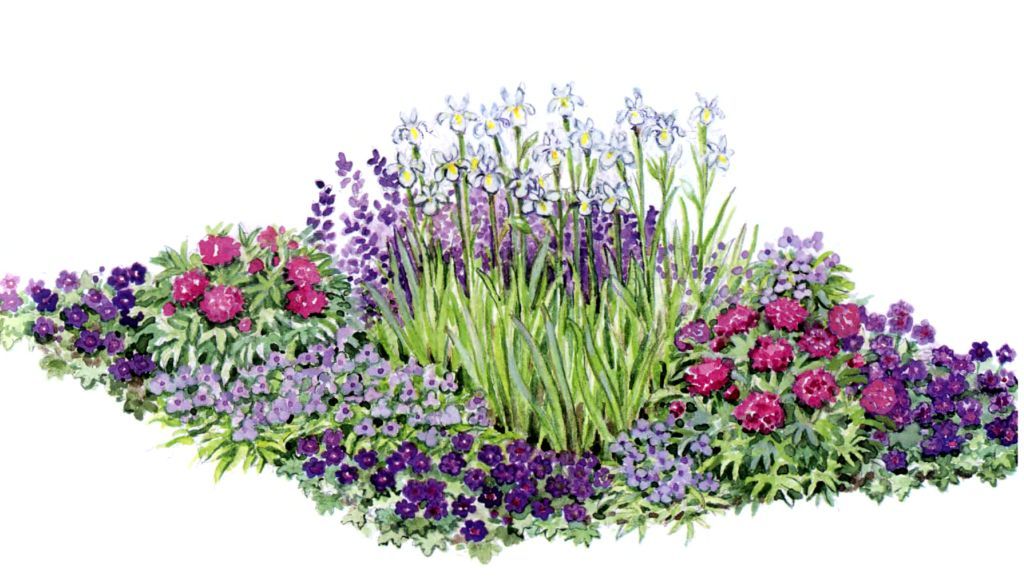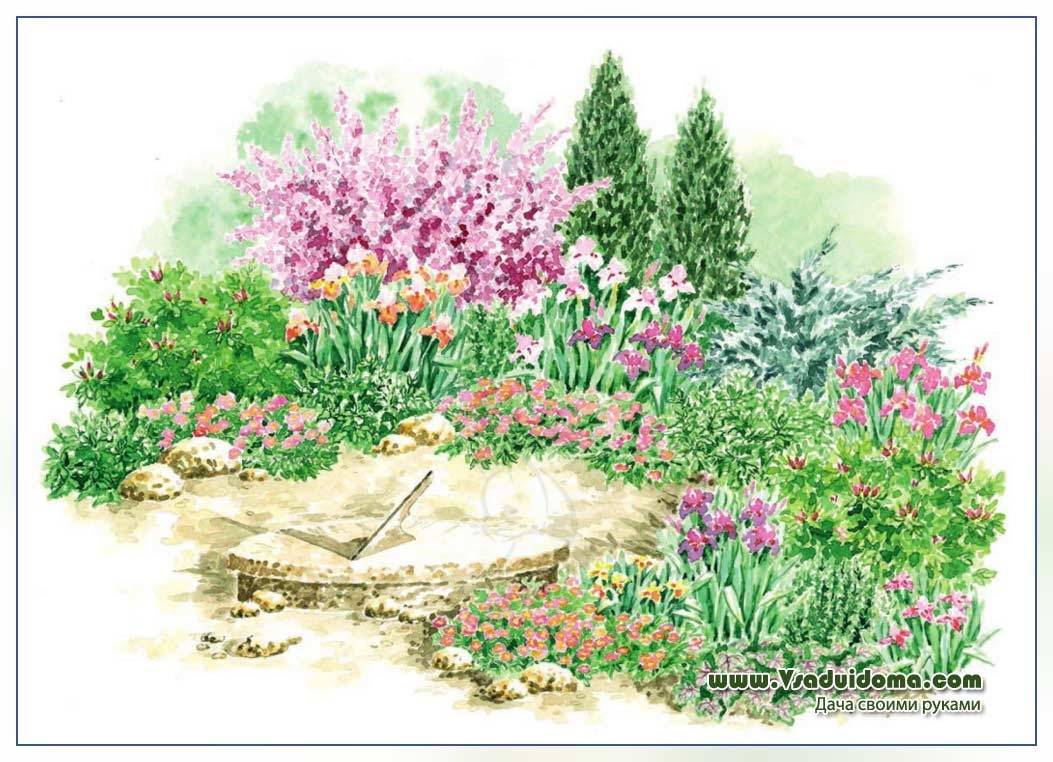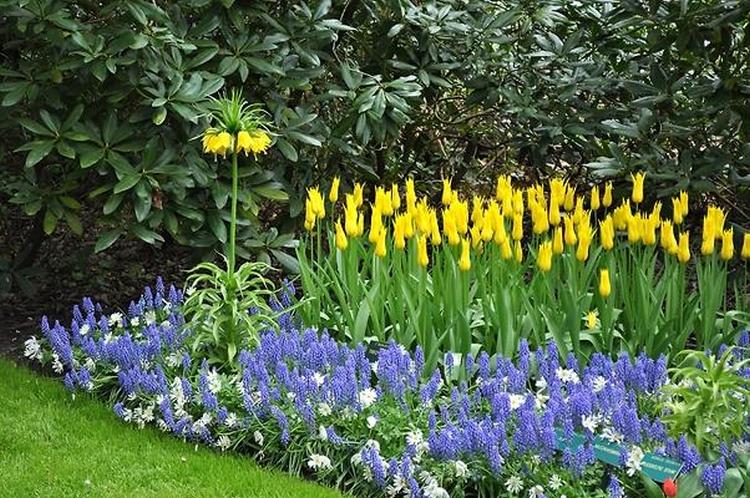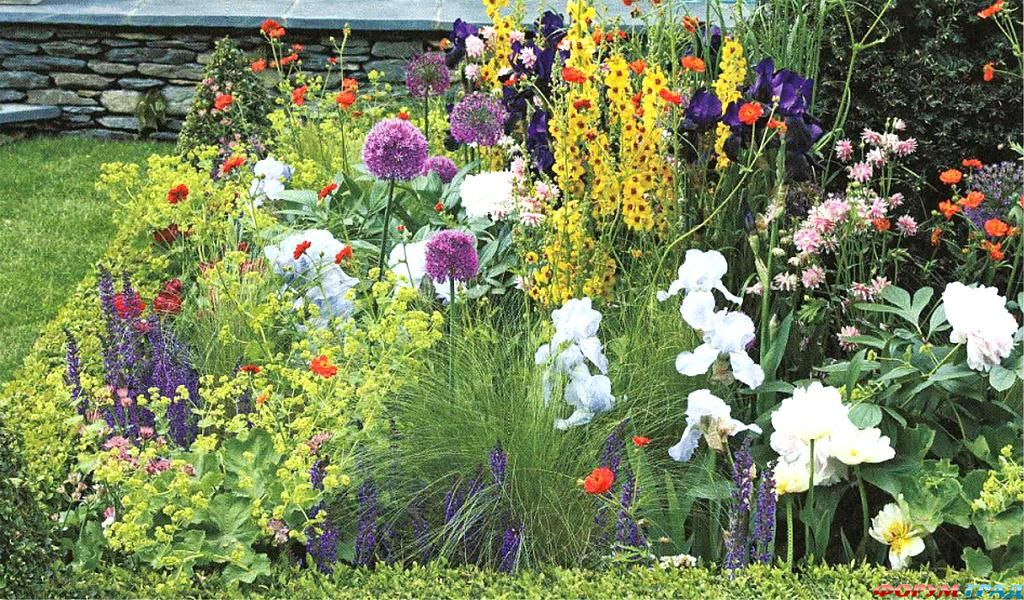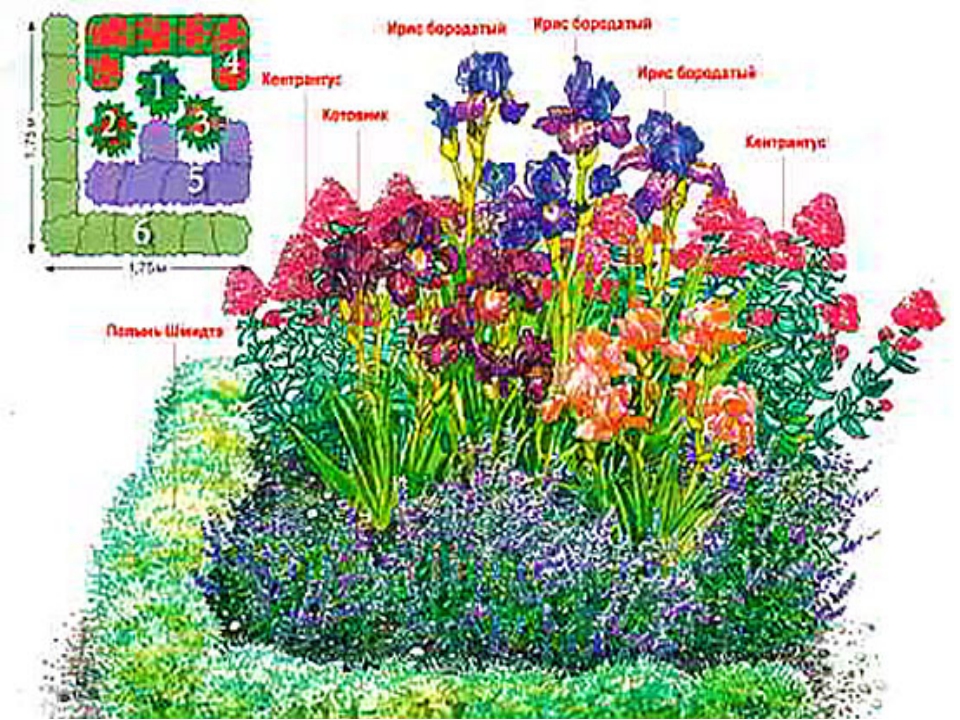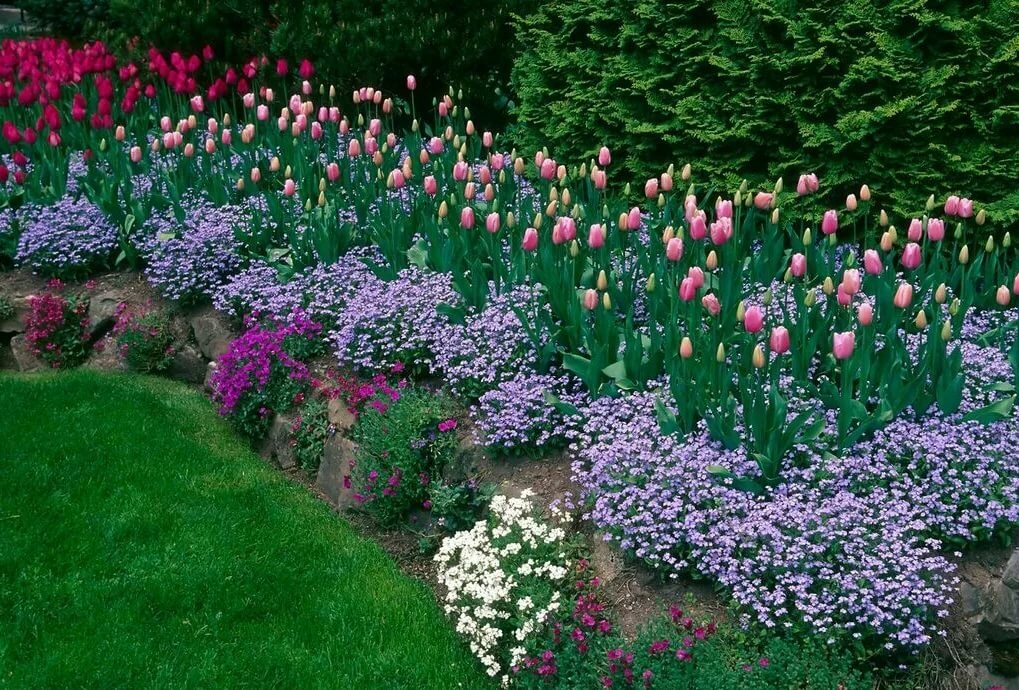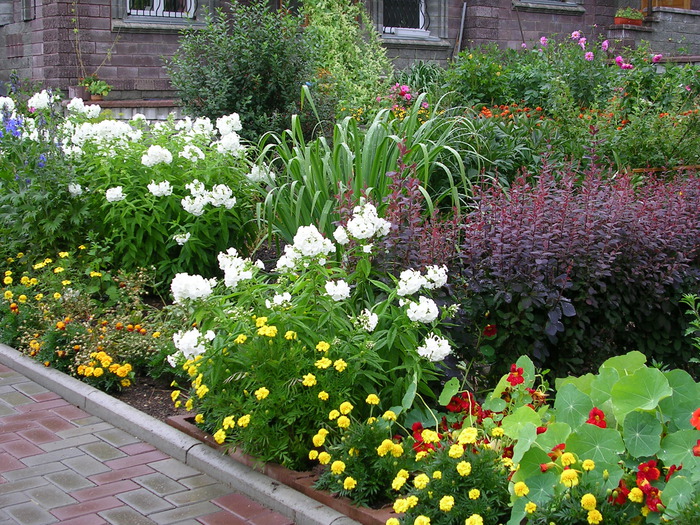Pond and rock garden with irises
The iris design is often used to decorate a garden pond: a pond or a stream. You can decorate a pond with almost irises alone, and it will be beautiful and natural, since they go well with water. Irises can also beautify the water itself: for example, water iris grows in water in shallow water.
If you have arranged a swamp flower bed in the garden, then irises are absolutely indispensable. Here you can plant bearded, and marsh, and water irises, complementing the composition with other marsh plants.
In the garden, irises are often part of the rock garden. All varieties of these flowers go well with conifers. Therefore, if you have planned a coniferous garden, there will be, by the way, their single plantings on its territory.
Pay attention to the photo of irises: in the garden, this Art Nouveau flower is perfectly combined with wrought iron elements. You can plant a group of irises against the background of a forged trellis
For the same reason, they go well with graceful decorative bridges.
Use in landscape design
In suburban areas with a large territory in the Art Nouveau style, you can find entire gardens of iris - iridarium. The indispensable attributes of this style are not only the presence of large quantities of irises, but also a source of water, stone and garden furniture made from traditional materials. When choosing a varietal variety for an iridarium, size, color, beginning, flowering duration and harmonious combination with other plants are taken into account.
In the Art Nouveau style, a group planting of irises decorates a variety of water sources, creating an incredibly beautiful landscape reflected in the water and harmoniously combined with the stone.
After all, even a small trickle can play the role of decorating a garden. In this case, irises are used in two varieties - smooth and marsh. They bring the landscape as close as possible to the pristine natural look. This is a real resting place. At the pond, irises are combined with representatives of conifers - thujas or dwarf pine. Swamp and Siberian varieties are located closer to the water. The free space between the plants is covered with pebbles or stone chips.
Multicolor compositions can also be found in flower beds.
Due to the short flowering, the plant is combined with other crops that bloom later to create an evenly changing picture. Planting iris in small groups can be carried out in a decorative basket, which is buried shallowly into the ground. Irises grow beautifully and decorate the landscape with spectacular views. If desired, you can dig it out after flowering, and plant annual garden plantings in the vacant space. With enough free space, every gardener can present his collection of irises in full glory.
A skillfully chosen color scheme is important. Plants with two or more shades are planted only if there is a solid background.
Mixing multicolor colors is undesirable. The background for multi-colored species can be pine needles, hostas and other plants of calm shades.
Irises are actively used as a tapeworm
For this, several units of different colors are planted. For example purple, pure white and white and purple iris. A well-groomed lawn, a wall of buildings or a non-flowering shrub is chosen as the background. Another option for the tapeworm is to plant irises in height. Tall, medium-sized and dwarf elements are used. The distance between them should be at least 50 cm. This harmonious composition against the background of dark soil or peat chips will look even more sophisticated.
Irises also adorn rockeries. Dwarf varieties grow on a stone hill.The "neighbors" of the iris can be crocuses, saxifrage, stonecrops, phlox and tulips. In a stone flower garden with junipers, irises of brown, purple and yellow shades are used as the main background. If light stones have become the background, then preference is given to a burgundy and dark blue iris. Sometimes rockery is also decorated with medium-sized irises, for example, bearded. This rare exception only appears if it does not out of proportion.
How else can irises be used in garden landscaping?
Designers willingly create single garden compositions - solitaires - from these luxurious, unpretentious flowers. For group planting, irises of the same type are usually taken, but in different shades. They can be placed against the background of a lawn or ornamental shrub that does not bloom. A composition of varieties that differ in height looks good.
Blooming irises
Another good option for using irises in landscape design is the design of a slide or rockery. For this purpose, it is best to plant miniature varieties. They combine saxifrage, stonecrop, crocuses, small tulips and creeping phlox. Flowers of a dark palette (brown, burgundy, deep purple) can be combined with light decorative stones. Yellow, blue irises should be planted against the background of creeping juniper.
The swamp or Siberian variety of perennial culture is an excellent addition to a natural or artificial pond, lake. A cozy place to relax is decorated with pebbles or gravel. The completeness of the garden composition will be given by the thuja, against which the irises are planted. Also, these flowers are good for decorating ridges, borders. They can be combined with other crops or used in monoplants.
When choosing perennial varieties by shade or height, consider the conditions for their cultivation. Not all irises can be combined with each other in the same area.
Types of phlox - choose the most beautiful
It is very difficult to highlight the most beautiful flowers, since each grower has his own. Some prefer low-growing bushes, others prefer tall ones with large inflorescences. Perennial phloxes are very popular among gardeners, since they are more unpretentious in care and do not require annual planting of seedlings.
All phloxes are good and beautiful in their own way, but the following are still considered the most popular:
- Snow Avalanche - refers to the early flowering pyramidal group. In height, these flowers grow up to 80 cm. Flowers are pure white.
- Delta is another flower belonging to the early blooming pyramidal group. The height of an adult plant does not exceed 1 meter. The flowers are white with a raspberry-colored center.
- Natasha - develops slowly and grows no more than 80 cm. Flowers are two-colored with white petals and wide crimson-pink stripes.
- Hummingbird - belongs to the representatives of small-colored phlox. Differs in branched and large conical inflorescences. Flowers of light lilac-blue shades with a lilac star in the center. Differs in high winter hardiness.
- Twinkling Star - star-shaped flowers with a characteristic fragrant aroma and pointed edges. Bushes are undersized. The flowering period is from June to September. Due to its miniature size, this variety can be grown on balconies.
- Ferdinand - grows to a height of 60 cm. Branched stems with needle-like, round, star-shaped, dissected petals. The color can be different. Differs in strong aroma and double flowering.
Phlox Snow Avalanche
- Davids Lavender is a powerful broad-leaved flower with oval-conical lilac inflorescences with a white center.
- Selena is a medium-sized plant, the height of the bush does not exceed 80 cm. Flowering begins in the middle of summer. Lush conical inflorescences of dark pink color with a gray haze.
- Bach - grows up to 80 cm in height. The flowers are medium-sized, dark pink in color with a raspberry ring, bloom in July.Flowers of this variety are sensitive to the sun and bad weather, so planting should be done in partial shade.
- Berendey is a compact flower with strong shoots and large, rounded inflorescences. The plant grows to a height of 80 cm. The flowers are large lilac, covered with a silvery bloom.
Phlox are very beautiful flowers, regardless of the variety and name. Their inflorescences do not leave anyone indifferent, so each gardener must decide for himself which of them to plant on his site.
Phlox David's Lavender
Bearded irises
Bearded irises are very common in landscape design. They combine several classes and are the largest group. They differ in height, which must be taken into account when using them in landscape design.
The creation of a radarium in the garden is very interesting. This is a flower garden that is built on a composition from one culture. Its dimensions correspond to the size of an average flower bed.
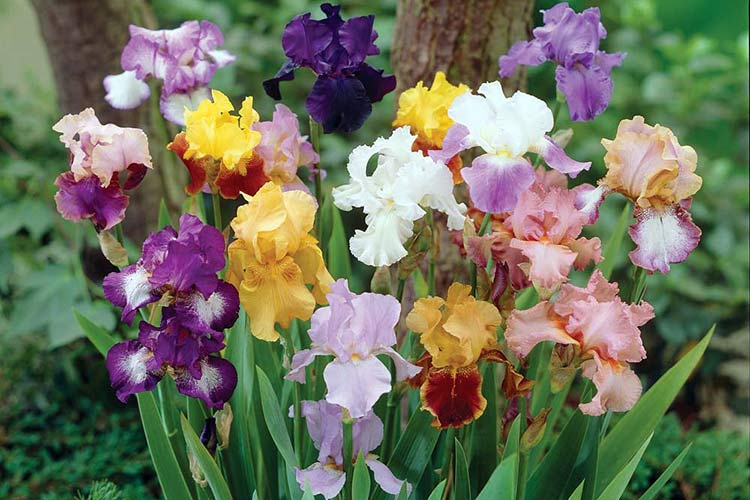
Bearded irises
Irises are in demand in garden landscaping. With the right iris combinations, your garden design can be completely transformed. Several varieties of irises of different colors can be placed in the iridarium. Landings are carried out in groups, the gap between them is filled with small pebbles. At the same time, do not forget to leave free space, which, as it grows, will be filled with overgrown plants.
Important! Plants are not recommended to be planted in rows, it is better to plant asymmetrically, like on an alpine slide. Borders can be either indistinct or limited by stones of various sizes
Borders can be either indistinct or limited by stones of various sizes.
Interesting. The iridarium will look harmonious even on a retaining wall.
You can supplement such a flower garden with cereals, but you should not be zealous, 2-3 groups of cereals are enough. Ceramics or various forging are used as decoration for the iridarium. These can be vessels of various shapes, original benches and bridges, carved fence.
How beautiful to plant irises? Additional decorations of the iridarium are very important - the period of flowering of irises is not very long. The rest of the time, the flower garden will simply delight the eye with greenery. Therefore, the introduction of additional elements is necessary.
Bearded irises are striking in their beauty and diversity - they can be either one-color or two-color, two-tone, iridescent and edged. With their help, it is easy to decorate the landscape, creating a bright flower garden out of it.
Lilies - what are they combined with in a flower bed?
If lilies grow in the garden, the combination with other flowers in the flower bed can be very different. Most often, novice florists practice combining with options such as:
- peonies,
- roses,
- day-lily,
- discount.
Each of these combinations has its own characteristics. Peonies and lilies are a great option. The lush foliage of peonies favorably sets off the beauty of other flowers, moreover, these plants bloom one after another: first peonies, then lilies.
Note! Gardeners often ask if roses can be planted next to lilies. Experienced florists do not recommend planting together, because both plants have large, expressive flowers.
However, if both crops are of the same color or shade, planting together is possible.
The one who plants lilies with irises makes a mistake. These plants have different flowering times. When irises bloom, watering must be limited, and their "neighbors" at this time are only blooming and, on the contrary, need strong soil moisture. Therefore, they do not have the best compatibility. But the friendship of the daylily and the lily, on the contrary, is not in doubt, because you need to take care of them in about the same way, and these flowers also have a similar aroma.
Lily will be the perfect complement to the discount. The Thunberg variety, which is short in stature and large, bright orange flowers with dark specks, is well suited for rabatki. This is one of the most popular varieties among Russian summer residents.
Use in landscape design
A special atmosphere of oriental flavor is created by irises in the garden, photos of the site's decoration perfectly demonstrate this. Iris in landscape design occupy a special place. Plants do not need regular care, the greenery retains its decorative effect throughout the season.
It is difficult to find a garden plot that does not grow irises
Irises bloom in spring or early summer, and some varieties bloom again in autumn.
When planting a decorative culture, several features must be taken into account:
- at a summer cottage in a group, buds of the same color range look unattractive;
- varieties with a pale color fade next to peonies, roses of saturated shades;
- bright irises do not fit well into the variegated picture of a flower bed, it is better to use them as a specimen.
Rhizome perennials do not need to be repotted frequently, the flowers form dense bushes. Iris buds come in different shades. Early flowering - blue, blue, purple with yellow and white hearts. Summer - in yellow-brown tones. Hybrid varieties with burgundy, white, lavender, peach, red flowers have been bred.
All rhizome irises love light, but can bloom under trees, especially in the southern regions.
The most magnificent perennial irises bloom in the third year after planting.
Forming alpine hills, irises are planted at the foot of the composition from the west or east.
Alpine slide - a suitable spot for planting irises
Lilies and hosts
This very successful combination is especially loved by landscape designers. Hosts cover unsightly lily stems with their large leaves. They grow rather slowly and do not cause problems for gardeners with weeding, and the large leaves of one bush can cover a whole square meter of the area around the lilies. So that in the spring the land in the flowerbed is not empty, because the hosts wake up quite late, plant snowdrops, muscari or crocuses on it. They do not bloom for long, so the hosta leaves overgrown in summer will not interfere with them. With a minimum of effort at the very beginning, such a flower bed will look well-groomed and decorative for many years. As they say, planted and forgot.
Flower arrangements
Interesting. When decorating a flower bed, you can use several schemes. So, bearded representatives look advantageous against the background of the lawn. You can also plant flowers in several colors. A good combination is one-color varieties in joint planting with two-ton irises, when one of the tones coincides with the color of one-color iris.
The landings bordering the reservoir look interesting. Plus, they love moisture. The feeling of a natural place is created. Don't forget about compositions with other plants.
What to plant next to irises? There are a lot of combinations, but there are also compositions that should be avoided:
- u Irises of similar shades do not look attractive in a group planting.
- u Varieties with pale flowers, when planted together with brightly colored irises, are lost and do not fit into the overall picture.
- u Joint planting of two-color specimens of different varieties looks very variegated and not harmonious.
- u Dark irises do not blend with other dark colors.
Excluding such combinations, you can create beautiful flower beds.
At the same time, it is important to take into account the flowering time of the planted plants so that the flower bed is pleasing to the eye throughout the season.
Irises with what are combined in a flower bed? Joint plantings with lupins or delphinium look beautiful. A good combination with lilies and poppies. At the same time, they do not harm each other, since the root system of these plants penetrates into the soil at different levels. It is preferable to plant such compositions in the center of the flower bed, grow low pansies or marigolds from the edge, forget-me-nots are also suitable.
Roses go well with them. The latter only benefit from this. The greenery near the rose covers the bare stems of the queen of the garden.When planting irises on the banks of artificial reservoirs, their joint planting with a swimsuit will be successful, and the host is also appropriate. Other plants that do well in moist soils will do as well.
Important! You can create amazing compositions, but you should not combine flowers with similar shades next to each other.
Flowers and their neighborhood - choosing candidates: photo
1. VELVETS Perfection1 F1. The bush is compact or spreading with a pronounced main shoot and completely round densely double inflorescences up to 15 cm in diameter.The bush is powerful, strong, well branched, 35-40 cm high, 30-35 cm wide.Plants look great in borders, flower beds and beds , go well with phlox, dahlias, asters, geraniums. Flowering from late June - early July until frost.
2. BRAHICOMA is an annual plant 15-25 cm high. The bushes have numerous inflorescences with flowers 3-3.5 cm in diameter. Reed flowers are white, blue, purple or lilac-pink; tubular (smaller) - blue or almost black. Abundant bloom, from mid-June to September or October, depending on the weather. Loves open, sunny places and light and nutritious soil. Watering is necessary only in dry weather; for abundant flowering, fertilizing with full mineral fertilizers is recommended. Planting after return frosts, the distance between plants is 15-20 cm.
3. CORN - a biennial or annual herb from 60 to 80 cm high. Flowers of garden forms can be white, pink, purple, red. Unpretentious, but loves sunlight, blooms from June to September. Grown in open ground in a sunlit place, the distance between individuals is 20-50 cm. When grown in a group of plants or flower beds, plant on the south side in the first row so that sunlight evenly falls on the leaves. Loves fertile, humus-rich soil with neutral acidity.
4. BEARDED DIATION - most often an annual crop up to 30 cm in height, strongly branches, forming a spherical bush. The flowers are small, up to 2 cm in diameter, pink in color, of different shades, often with a yellow spot in the neck. It tolerates a lack of moisture well. therefore, it is quite suitable for planting in containers, it is widely used to decorate the borders of mixborders, the edges of flower beds and garden paths.
5. NEMESIA ZANOVIDNAYA - an annual plant 30-40 cm high. The flowers are bright orange, yellow, pink, red or variegated, up to 2.5 cm in diameter. This is one of the best annuals for borders or groups in prefabricated flower beds, as well as for planting in flowerpots and balcony boxes. Flowering continues until the end of September. To provoke a second wave of flowering, cut off the faded stems at a height of 15-20 cm from the ground
The device of a flower garden of continuous flowering
Each owner wants to have flowering plants on his site almost all year round. How can this be achieved?
There are certain rules here:
- The place of the future flower garden is divided into small areas with different seedlings in each of them. Moreover, such a combination is provided so that the flowering time of different plants in each segment does not coincide, i.e. one flower fades and the other blooms.
- To ensure the continuity of the flowering of the garden from March to November, it is necessary to have enough space on the site to plant a large number of plants. It should be borne in mind that, depending on the size of the plants, you can plant from 2 to 10 bushes per square meter of flower beds. Therefore, in order to solve the problem of creating a continuously blooming oasis, it is necessary to have an area of at least 2-3 squares for this.
- A great difficulty in creating a flowering garden is the compatibility of plants, taking into account the various features of caring for them. For example, bulbous plants require nitrogen fertilization for good flowering, and rhizome perennial plants, with an excess of nitrogen, go into growth to the detriment of flowering.In addition, bulbous, early blooming flowers fade when perennials are just getting ready to bloom. And digging up the bulbs after they bloom can damage neighboring plants, which will affect their flowering. Therefore, it is preferable to plant bulbous plants that do not need generous fertilization and annual digging.
- Perennial flowering plants do not always have time to bloom at the time when primroses are fading, because they need a certain time to settle down on the site. Therefore, it is good to plant annuals between early flowering and perennial plants, which will close the wilting primroses and bloom the flower bed. Such flower garden rescuers include pansies, forget-me-nots, daisies.
- It should also be taken into account that not all plants harmoniously combine the attractiveness of the flower, the beautiful shape of the leaf and the colorfulness of the greenery. Therefore, it is necessary to correctly arrange various flowers, so that some "cover up" the shortcomings of others.
Combination with small-flowered
Large glasses of lilies look incredibly attractive and aristocratic against the background of plants with small flowers. Plant a yarrow next to them. It comes in many varieties with white or pink buds. Delightfully combined with lilies yarrow ptarmica. Don't like yarrow? Replace it with Perennial Iberis. The effect will be the same.
The lily bush looks very decorative (there is a photo of flowers in the flower bed in the article) surrounded by small balls of tall anaphalis of pearl or fluffy bush of small-flowered gypsophila. The twigs of these plants, they are also called "pearl mussels", are often added by florists to bouquets with lilies or roses.
Fragrant alyssum or mattiola will hide the unsightly lower branches of the lily and, mixing with its scent, create a divine cocktail of scents. Arrange this flower bed near the window of a house or a veranda and in the evenings you will enjoy the fragrance of paradise.
Planning a flower bed
When planning a flower bed, pay attention to some of the subtleties:
- All plants follow the sun with their heads. And if the view of the flowerbed opens from the north side, then most of the day the flowers will be turned away from you. In such a flower bed, you can plant flowers in which the following to the sun is not so pronounced. These are zinnias, marigolds; of perennials - lupine, irises, liatris, delphinium, Buzulnik Rocket.
- If the flower bed is located near the fence through which passers-by can see your flowers, decide in advance: you will make a flower bed for yourself or so that passers-by will have a spectacular view of your flower garden.
- Leave sufficient distance between flower groups when sowing. And let the flowerbed look somewhat loose by the end of June. But in July, you will not have to free less aggressive plants from spreading counterparts.
- When planning a flower bed, always refer to the plant height indicated on the seed packaging, and also observe the indicated distance between plants of the same species. If the sown seedlings have sprouted too often, they can be carefully dug up and transferred to another place. Remember that some plants do not tolerate transplanting very well. For example, from annuals - escholzia and poppy, from perennials - gypsophila, oriental poppy and, as a rule, all plants with a taproot system.
- If you are planning to collect seeds from flowers from a mixture of colors of a certain color - mark the selected plant in advance, as soon as it begins to bloom, do not postpone it for another day! The next weekend, this plant may already bloom and get lost among the multi-colored comrades.
- Remember that for long-term flowering of both summer and perennial flowers, it is necessary to periodically remove faded flowers, as well as ovaries and fruits. This will help maintain the decorativeness of the flower garden and the re-flowering of some plants.Perennial flowers such as lupine, Turkish carnation, bells, delphinium are recommended to be cut when almost all flowers have faded. After such pruning, perennials can please you with repeated flowering.
- Do not sow a plant of the same type over a large area. When the time comes and this plant finishes flowering, the site will take on an unsightly appearance or completely bare, which cannot but upset.
- It is curious that there are flowers that close in cloudy weather (escholzia). Bindweed tricolor rolls up its gramophone in the afternoon. Conversely, mattiola, inconspicuous during the day, opens up and smells sweet in the evening and at night.
In the summer, write down your plans for the next season. Do not rely on memory, but write down which plants you liked from your neighbor and you also want to grow them; what they wanted to take from a friend; what they promised to share with neighbors; what plants need to be divided and planted in the spring ...
Another use of the versatile trios for flower beds
Combinations of plants, with the help of which you can create the simplest of flower beds, are a universal combination of plants that "works" not only in individual compositions. If you suddenly have a need to quickly "patch holes" in large flower beds or flower beds, a bald spot suddenly appears between your favorite plants, then you can easily close it using one of the three plants in combination. It is enough to inspect the neighbors - and the concealer will be found himself. So, between phlox and delphiniums, a bush of one of the hybrid varieties of helenium will easily close the void, and geraniums can be planted between poppies and irises.
The use of irises in flower beds and the design of reservoirs
Irises look very stylish and harmonious in the composition of flower beds. Other plants stand out organically against their background. The thing is that they are usually created in bluish-blue shades. This range in itself is quite unusual and rare. That is why it is often these shades that are just not enough when decorating a flower garden.
Irises look no less stylish as part of the creation of mono flowers. In this solution, it is recommended to give the element of landscape design an appropriate frame. To do this, you can use gravel filling or natural cane.
Irises are often used in the design of reservoirs.
Advice. Ornamental cereals should be used as an original and harmonious addition to irises in the context of a mono flower.
If there is a reservoir on the territory of the garden, then for its design it is necessary to use irises. By the way, only this flower can be planted around a stream or pond. This plant goes well with water and feels good in wet soil. Such a solution will look as natural and beautiful as possible.
The attractiveness of irises lies in the fact that they can be used to decorate the reservoir itself. The main thing is to choose the right variety of this flower. This solution looks non-trivial and very impressive. Accompanying plants are not required to obtain the desired picture.
What to plant with
Lilies should not be planted next to irises. Despite the fact that they have different flowering times, and in appearance these plants seem to be compatible, such a neighborhood will adversely affect both. The fact is that faded irises should never be watered. Their main root, located on the surface of the earth, will quickly rot, and lilies during the flowering period require regular moistening of the root section of the soil.
The second unfortunate neighbor of the lily is the tulip. These flowers have common diseases.
In addition, tulip bulbs invariably attract the attention of mice. Having torn the tulips, they will also gnaw the lily bulbs at the same time
And they, especially varietal ones, are very expensive and are rarely available for sale.If you want a flower bed with lilies to delight with flowers all summer, starting in spring, plant daffodils or a grove near it.
Experienced gardeners, who do not want to part with tulips, dig in lily bulbs along with plastic or metal cans. With their walls, they block access to them for both mice and other pests.
The jar is trimmed at the top and bottom and hammered into the ground around the bulb with a hammer. This will subsequently make watering difficult, but will keep valuable specimens from garden vandals.
The best flower arrangements
Over the years of cultivation, flower growers have created truly enchanting compositions with irises that can please the eye for more than one season. This arsenal continues to grow with new ideas from year to year.
Duet with daylilies
Daylilies can be planted next to irises, which also have a superficial root system. Plants do not compete with each other, need the same amount of moisture and require almost the same care. The disadvantage is that the flowering dates of some varieties may coincide, therefore, the flower bed will be empty for a certain period of time.
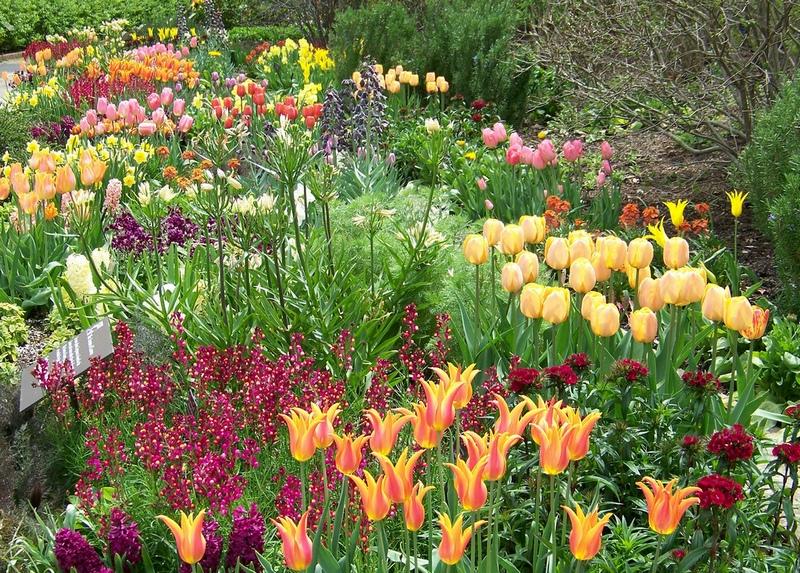
Flowerbeds of irises with roses, peonies
Roses and irises go well in flower beds. Rose bushes bloom later than iris, but green leafy stems are a great decoration and background for blossoming buds. Experts recommend choosing plants by color combination.
Peonies also harmonize well with this plant, even though they occupy a dominant position in any compositions. Irises are planted around the peony bush. They bloom one after another, so the flower bed will not look empty and dull.
Iris border
Dwarf varieties are perfect for decorating the borders along the path. To make them more decorative, they are planted among large stones. Medium-sized varieties with purple or white flowers will also look great. Due to the short flowering period, it is recommended to plant irises together with other plants or create a background of conifers so that the border does not lose its attractiveness throughout the season.

Mono flowers with irises or iridaria
The combination of irises with different flowering periods in the same flower bed is called iridariums. If everything is calculated correctly, then bright colors will delight the eye from May to early August. The greenery of the grass will be an excellent background for flowers, so you can plant them right in the middle of a green lawn or lawn.
When compiling groups, not only the timing of flowering is taken into account, but also the color of the petals. The varieties are planted at some distance from each other, filling the empty space with pebbles or colored pebbles
It is not recommended to plant irises in a row; asymmetry is preferred. The iridarium is decorated not only with forged products, but also with a small carved fence. Berry greens will help to complement the beauty.

